By Guillermo Anderson : With the help of the German Development Agency, (GTZ) Project Biosfera RIO PLATANO - PRORENA BRPI am now working on a recording that will include some musical elements and rhythms of the Misquito Culture.
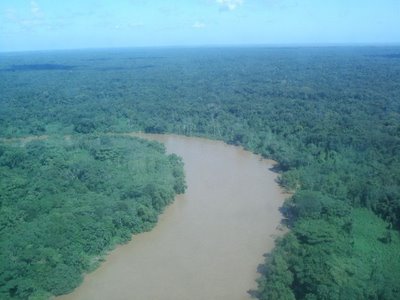
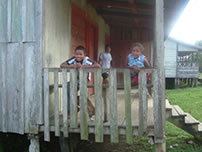
La Mosquitia
La Mosquitia is a wilderness region in eastern Honduras shared by Honduras and Nicaragua. It is our Central American Amazonia. It holds some of the world’s most diverse flora and fauna. It also includes everything from rain forest to lagoons, rivers, mangroves and miles of coast. The Mosquitia holds the Rio Platano Biosphere Reserve. The richness and diversity in this reserve has such importance that it was declared a World Heritage site by UNESCO in 1996. The PeopleThe Mosquitia is also home to a diversity of cultural groups. The Pech, Tawahka, Garifuna and Misquito people make this place rich with cultural diversity. My interest in this trip was the Misquito. This group is first descendant of the Sumu groups that came from South America. Of great interest to the colonial powers for its precious red wood, Spain was the first to send missions to settle the area. The first missions succumbed to the harsh environment and to the Sumu attacks. The area was eventually invaded and settled by the English who brought along African slaves to help colonize the area. Today this mixture of Indian, African, English and Spanish makes up the Misquito culture.


Some time ago I had played a concert in the town of Belen, about a four hour boat ride down from Brus, and made a few friends. I was gladly surprised to know that my music for children has been used for a few years by teachers in this region to teach children music and conservation.

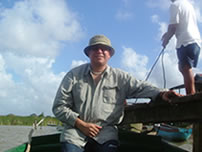
Before The Workshop, Off To See the Landscape
After our meeting and lunch we decide to see some of the landscape surrounding the lagoon. We hire a “pipante” the traditional Misquito open boat with a guide to show us around. This pipante however is not propelled by a long stick in the traditional manner here, but by a 45 outboard motor. We leave the towns main dock and head through the waterways to the Lagoon. Once in the Lagoon we can feel the strong breeze and the boat moving with the waves. We can now see the size of this body of water. Some cargo boats are trapped inside the lagoon; they depend on the natural opening of the lagoons entrance to the sea and wait for the next rains so the rivers bring enough water to deepen it.

I don’t know if my friend José is enjoying the ride In Brus Lagoon or not.
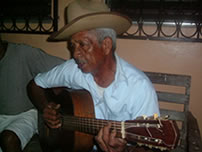
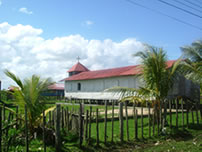 An Old Wooden Church In Brus Laguna
An Old Wooden Church In Brus Laguna

With the help of the German Development Agency, (GTZ) Project Biosfera RIO PLATANO - PRORENA BRPI am now working on a recording that will include some musical elements and rhythms of the Misquito Culture. The idea is to also be able to talk to my Honduran audiences about an area of the country and its peoples of which they know very little about. As part of the research for the CD, the project’s coordinator, African Musician and Songwriter Jose Fermin Molongua and I made a trip to Brus Laguna, a town in the Mosquitia region in eastern Honduras. We went there with the purpose of meeting some local traditional musicians and become yet more familiar with the rhythms and styles, especially of guitar playing in the Misquito culture.

La Mosquitia
La Mosquitia is a wilderness region in eastern Honduras shared by Honduras and Nicaragua. It is our Central American Amazonia. It holds some of the world’s most diverse flora and fauna. It also includes everything from rain forest to lagoons, rivers, mangroves and miles of coast. The Mosquitia holds the Rio Platano Biosphere Reserve. The richness and diversity in this reserve has such importance that it was declared a World Heritage site by UNESCO in 1996. The PeopleThe Mosquitia is also home to a diversity of cultural groups. The Pech, Tawahka, Garifuna and Misquito people make this place rich with cultural diversity. My interest in this trip was the Misquito. This group is first descendant of the Sumu groups that came from South America. Of great interest to the colonial powers for its precious red wood, Spain was the first to send missions to settle the area. The first missions succumbed to the harsh environment and to the Sumu attacks. The area was eventually invaded and settled by the English who brought along African slaves to help colonize the area. Today this mixture of Indian, African, English and Spanish makes up the Misquito culture.

Getting There
We arrived in a small airplane from La Ceiba. There are flights 3 days a week to Brus Laguna. There is still very little tourism coming this way. The passengers on our flight were locals who come to La Ceiba to bring goods, some development workers and a couple from the US that are here to see the Rio Platano Biosphere with the help of an eco-tourist guide. The first impression that towns in this region give the traveler is the wooden houses on stilts. These are lowlands and In the rainy season these lands will flood.A strong first impression for us Honduras is the language. Many of us who live in the rest of Honduras don’t know how strongly Misquito language is spoken here. Unlike other ethnic groups in the country who everyday speak more “bilingually” (their language and Spanish that is), The Misquito are very proud of their language, a mixture of their Sumu Indian origin, English and Spanish. Finding Friends

Some time ago I had played a concert in the town of Belen, about a four hour boat ride down from Brus, and made a few friends. I was gladly surprised to know that my music for children has been used for a few years by teachers in this region to teach children music and conservation.

Concert in The Town Of Belen
We found Teacher John Cooper Wood. English names in the Misquito people are common because of the English presence in the region. He was glad to see us and grateful that we would be interested in Misquito Culture.La Mosquitia has been an isolated region of Honduras for years and governments have rarely given any attention to its development, needless to say its culture. For years and through being a teacher in La Mosquitia, John Cooper has tried to preserve Misquito Culture organizing music and dance groups with his students. We decide to meet later to talk some more and do some recordings, but especially so I can “workshop” some of these rhythms on guitar, that I still feel I don’t come close to playing. Fortunately John offers to bring along his father Don Juan Cooper. Don Juan is a very popular Misquito guitarist, singer and songwriter. Even at the age of 86 and his complaining that “he’s too old”, he has great ability for playing the instrument.

Before The Workshop, Off To See the Landscape
After our meeting and lunch we decide to see some of the landscape surrounding the lagoon. We hire a “pipante” the traditional Misquito open boat with a guide to show us around. This pipante however is not propelled by a long stick in the traditional manner here, but by a 45 outboard motor. We leave the towns main dock and head through the waterways to the Lagoon. Once in the Lagoon we can feel the strong breeze and the boat moving with the waves. We can now see the size of this body of water. Some cargo boats are trapped inside the lagoon; they depend on the natural opening of the lagoons entrance to the sea and wait for the next rains so the rivers bring enough water to deepen it.
According to historians the first English man to settle in the area was a man by the last name of Brewers, so to the English it was known first as “Brewers Lagoon” hence the later name of “Brus Laguna”.When I ask about what seem to be small camps scattered about, we learn about excessive fishing in the lagoon. Unfortunately there is no control regarding fishing with large nets. Someone told me that there could be 400 to 500 hundred of these nets in the lagoon at a time. It’s amazing how generous nature can be. You would think it would have given up a long time ago. This area is so rich and could be richer in fish and natural resources with some control. My brother Patrick, bass player in my band and geographer taught me the term TBPC “Territory Beyond Political Control” This area seems to be beyond ecological control as well. The boat is swaying a bit more as we come to the center of the lagoon.

I don’t know if my friend José is enjoying the ride In Brus Lagoon or not.
Then we head into one of the river way the Sigre River, we follow it a couple of miles up river to see the thick vegetation on its sides. Our guides tell us it’s this way for miles and miles. It’s comforting to know that some areas of the world remain that way. We head back to the lagoon were we see more fishing camps.Our guide makes jokes about crocodiles in these waters. We don’t know how to take them. He says you can catch good fish around here. When I get home I can hear my father asking me if I took a fishing line to see if I could catch a “rovalo”.
Ahead of us we begin to see two small Islands that sit in the middle of the lagoon. One of them is Cannon Island. The island is famous for being a stronghold of English pirates and corsairs who set up a camp and set up cannons all around it to hit on Spanish vessels which attempted to come into the lagoon. Unfortunately, my camera battery ran out once we got to Cannon Island (amateur journalist that I am) the place has been turned into a small resort that for years, has catered to sport fishermen. I understand it will now welcome eco-tourists. The island is idyllic; the tiny resort is surrounded by abundant tropical vegetation and is nesting grounds for all kinds of sea bird species and its trees for hundreds of iguanas.Our guide tells us we must get back to Brus before it gets dark. We must prepare ourselves for we will be motoring against the wind. We leave behind beautiful Cannon Island. Once in the lagoon we see many small pipante heading out to fish.
Ahead of us we begin to see two small Islands that sit in the middle of the lagoon. One of them is Cannon Island. The island is famous for being a stronghold of English pirates and corsairs who set up a camp and set up cannons all around it to hit on Spanish vessels which attempted to come into the lagoon. Unfortunately, my camera battery ran out once we got to Cannon Island (amateur journalist that I am) the place has been turned into a small resort that for years, has catered to sport fishermen. I understand it will now welcome eco-tourists. The island is idyllic; the tiny resort is surrounded by abundant tropical vegetation and is nesting grounds for all kinds of sea bird species and its trees for hundreds of iguanas.Our guide tells us we must get back to Brus before it gets dark. We must prepare ourselves for we will be motoring against the wind. We leave behind beautiful Cannon Island. Once in the lagoon we see many small pipante heading out to fish.
The open air and the breathtaking beauty reassure my love of water and its lifestyle. It reassures my love for this beautiful part of the world. We come close to town and we land in a neighborhood where we were told, was where the village of Brus began. The houses are on stilts over the water, the women are washing clothes in the lagoon and the children are bathing and jumping of the anchored pipantes. The men are working on their nets and radios are blasting news or music. Everywhere I go I can’t help wondering what a childhood is like in the place. It is such a privilege to grow up with the freedom children have in these villages. In a typical non- school day they wake up and bathe in the lagoon under the sun, and then they will head out with their friends to hunt for iguanas or go fishing in one of the waterways.

The “Teachings of Don Juan”
At night we meet with Don Juan Cooper, his son and a young musician from a nearby village. As soon as Don Juan begins to play, the corridor of the house is filled with curious townsfolk eager to listen to this man. They can hardly hide their joy at the chance of hearing someone that hardly ever takes out his guitar anymore. One of the bystanders cannot hold his dancing feet and starts to dance alone in the corridor. The sounds of the guitar bring out something very strong in the soul of these people. In this visit we have witnessed how the invasion of the loud generators and stereos in the towns bars have begun to silence an instrument that was once king of the Misquito coasts nights. Later, when I record an interview with Don Juan, he tells me how the evangelical preachers don’t want him to play any of his songs, calling them “worldly” music. I find it sad to see how the Heritage of a people can be so easily erased by the preaching of religious fanatics. For Don Juan, the saddest part is that originally it was foreign missionaries condemning his music, now its Misquito preachers trying to prevent him from playing what they call “the devils music”. “If you get to know them” he adds you can see that they have no education, they have never been beyond La Mosquitia, and don’t know our music can be appreciated in other parts of the world”.
At night we meet with Don Juan Cooper, his son and a young musician from a nearby village. As soon as Don Juan begins to play, the corridor of the house is filled with curious townsfolk eager to listen to this man. They can hardly hide their joy at the chance of hearing someone that hardly ever takes out his guitar anymore. One of the bystanders cannot hold his dancing feet and starts to dance alone in the corridor. The sounds of the guitar bring out something very strong in the soul of these people. In this visit we have witnessed how the invasion of the loud generators and stereos in the towns bars have begun to silence an instrument that was once king of the Misquito coasts nights. Later, when I record an interview with Don Juan, he tells me how the evangelical preachers don’t want him to play any of his songs, calling them “worldly” music. I find it sad to see how the Heritage of a people can be so easily erased by the preaching of religious fanatics. For Don Juan, the saddest part is that originally it was foreign missionaries condemning his music, now its Misquito preachers trying to prevent him from playing what they call “the devils music”. “If you get to know them” he adds you can see that they have no education, they have never been beyond La Mosquitia, and don’t know our music can be appreciated in other parts of the world”.
 An Old Wooden Church In Brus Laguna
An Old Wooden Church In Brus LagunaI don’t want my readers to think that Misquito rhythms are something extremely complicated, and exotic, or that it’s a harmonically challenging style. It’s more about the groove, about, the details in the strumming and about finding the “swing” in these African influenced rhythms. There are those great moments when our questions about things we are fascinated by are being satisfied. I am fascinated by the origins of styles and musical genres, where they come from, the unending web and movement of cultures intertwining. Interviewing and playing with Don Juan and the younger Misquito musicians that meet us at night was one of those moments.I have been very intrigued by Misquito guitar and the fascination of the Misquito people with the instrument. Having the chance of not only listening but sharing, asking and just playing with these folk musicians was great.
When I have learned these styles I know I will probably come close to the technique and the timing, but this not being entirely my culture means I will never play like them.When someone like Don Juan Cooper is playing he is not only playing the rhythm. He is playing his life as a child here. He is playing his language, the way he has fished or grown cassava, the maidens he seduced with his playing, the endless full moon nights playing in towns when there were no generators interrupting the singing of the crickets or stereos blasting in the bars. The way that he sees the landscape, and the way his culture views life and death. When someone like Don Juan plays his guitar he plays his culture. A culture we can only embrace, appreciate and respect.

Epilogue
Who is to know what will happen to this music in the future? To judge by the way things are developing in La Mosquitia we are probably witnessing the last signs of survival of these cultural expressions. Despite it being declared World Heritage Site and the work of a few organizations trying to prevent it, this area is being destroyed everyday by illegal woodcutters, uncontrolled fishing and settlers. Traditional culture is always as vulnerable as natural resources. Jose and I begin to talk about a good compilation and a dignified recording of these artists. To this day you cannot find a Misquito music CD in any record store in Honduras. He has been fascinated by the people,the pride they show in their language and by the friendly children who enjoy the happiness of the freedom that comes with growing up here. I am definitely inspired to write, sing and talk about these people, their culture and the importance of preserving this wonderful natural treasure.-
For this trip and project I thank the help of:
Project Biosfera RIO PLATANO - PRORENA BRPMusician an Songwriter Jose F. Molongua German Development Agency (GTZ) Professor John Cooper Wood,Don Juan Cooper Wood The people of Brus Laguna, La Mosquitia, Honduras.
Copyright © GuillermoAnderson.com 2005 Diseño: www.holaceibita.com
Guillermo Anderson Web Site:
Guillermo Anderson in la Mosquitia
No hay comentarios:
Publicar un comentario